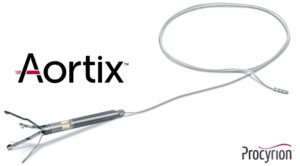
Procyrion, a medical device company which aims to improve outcomes for patients with cardiac and renal impairment, announced today that use of its Aortix percutaneous mechanical circulatory support (pMCS) device led to rapid decongestion in a pilot study of patients admitted to the hospital with acute decompensated heart failure (ADHF) and worsening renal function, which is known as cardiorenal syndrome (CRS).
These patients, who were unresponsive to available medical therapy, demonstrated significant improvements in kidney function, cardiac function, and patient-reported assessment of shortness of breath at 30 days after treatment with the Aortix pump. The results from the CRS pilot study were presented today during the late-breaking clinical science session at the Technology and Heart Failure Therapeutics (THT) 2023 conference (20–22 March, Boston, USA).
Late-breaking data presented at THT shows substantial fluid loss and improvements in kidney and cardiac function at 30 days after Aortix pump therapy in patients admitted to the hospital with acute decompensated heart failure (ADHF) and worsening rnal function, which is known as cardiorenal syndrome (CRS).
Late-breaking data presented at THT shows substantial fluid loss and improvements in kidney and cardiac function at 30 days after Aortix pump therapy in patients admitted to the hospital with acute decompensated heart failure (ADHF) and worsening renal function, which is known as cardiorenal syndrome (CRS).
“Patients admitted to the hospital with CRS are the most difficult to treat. They often have persistent congestion even after aggressive intravenous diuretic therapy, leading to very poor outcomes with high rates of mortality and rehospitalisation,” stated Jennifer A Cowger (Henry Ford Hospital, Detroit, USA). “After being unresponsive to available medical therapy for more than a week, patients who were treated with the Aortix pump showed a significant increase in urine output resulting in a large loss of excess fluid and improvements in kidney function present at 30 days, indicating the potential of the Aortix therapy to disrupt the harmful cycle of CRS.”
CRS is a complex disease with cardiac, renal, and neurohormonal components, impacting up to 40% of all patients admitted with ADHF in the US and growing at a double-digit rate. In CRS, underlying heart failure leads to reduced blood flow to the kidneys, which causes the kidneys to become less effective at removing excess fluid from the body. This can lead to symptoms such as swelling in the lower limbs and abdomen, congestion, shortness of breath, and fatigue, making it difficult for patients to engage in everyday activities. Effective treatment options for CRS with persistent congestion are lacking, as evidenced by up to a 25% heart failure rehospitalisation or mortality rate at 30 days for those patients who remained clinically congested after 96 hours of optimal medical therapy and were discharged from the hospital.
The CRS pilot study treated 18 patients across 10 centres in the US and in Australia. Statistically significant observations include:
- Rapid decongestion as patients shed on average 10.7 litres of excess fluid
- Filling pressures (central venous pressure and pulmonary capillary wedge pressure) decreased by over 33%
- Kidney function improved by a median of 29% at 30 days, as measured by eGFR
- Cardiac function improved by a median of 34% at 30 days, as measured by an important biomarker of heart failure (NT-proBNP)
- Shortness of breath symptoms were reduced by 46% at 30 days
The Aortix pump was placed in the descending thoracic aorta via a percutaneous catheter procedure and treated patients for a mean of 4.6 days to simultaneously unload and rest the heart and increase perfusion of the kidneys. The innovative design uses intra-aortic placement and harnesses fluid entrainment to pump blood without the need of a valve and provides physiologically natural delivery of therapy. Use of the system easily integrates into practices as the Aortix system can be implanted in approximately 45 minutes and retrieved in about 15 minutes at the completion of therapy. No fluid purges or expensive consoles are required to operate the device.
“The consistent results from the pilot study indicate that Aortix therapy has the potential to be a major therapeutic advancement for CRS patients who have exhausted other treatment options,” stated Eric S Fain, president and chief executive officer at Procyrion. “After years of development, it is very exciting to see how well the Aortix platform performs clinically and we look forward to further demonstrating the effectiveness of the system in our upcoming DRAIN-HF pivotal trial, which the company plans to initiate later this year.”








